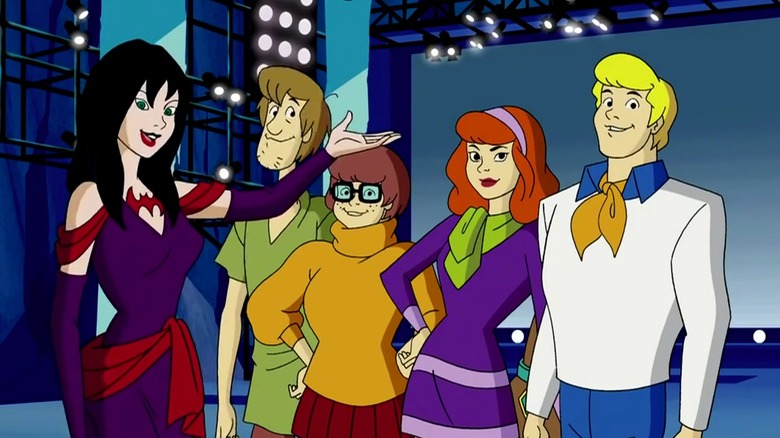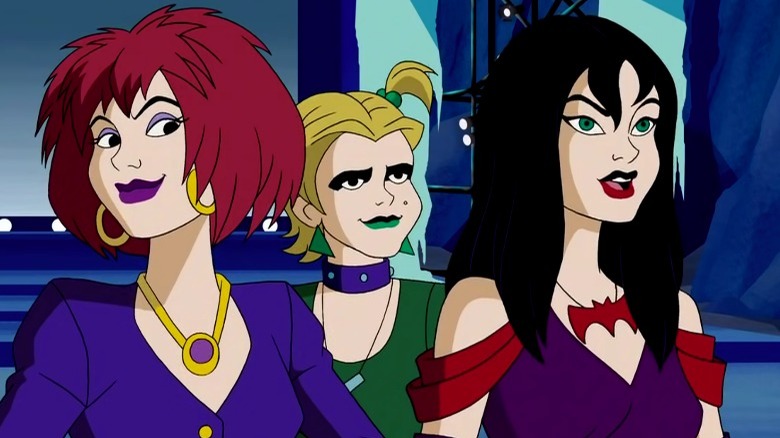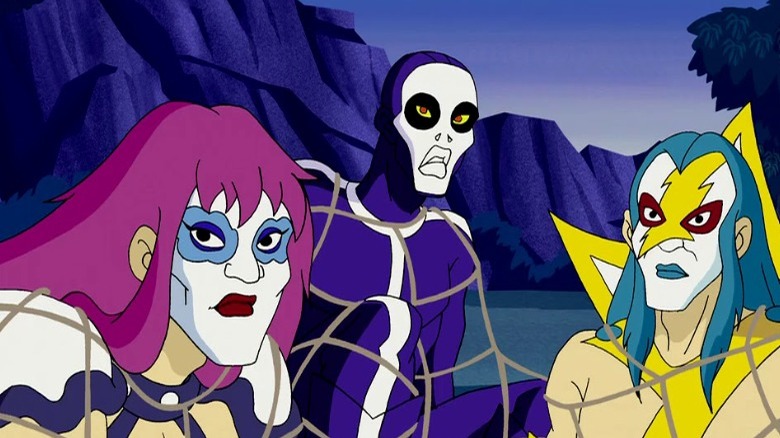Year Of The Vampire: Scooby-Doo And The Legend Of The Vampire Is Part Of An Excellent Horror Kid Starter Pack
(Welcome to Year of the Vampire, a series examining the greatest, strangest, and sometimes overlooked vampire movies of all time in honor of "Nosferatu," which turns 100 this year.)
Hardcore Scooby-Doo fans, of which I am one, will tell you that one of the franchise's high water marks came during the dawn of their direct-to-video movies. From 1998 to 2003, Warner Bros. and Hanna-Barbara made five movies that set the new standard for what a Scooby film could look like, mixing a fresh animation style with genuine thrills and a more mature Mystery Inc.
In "Scooby-Doo on Zombie Island," the best of the bunch (meet me back here on the 100th anniversary of "The Wolf Man" to talk about that one), the once-estranged gang reunites after time apart to chase monsters that for once turn out to be real. By the time "Scooby-Doo and the Legend of the Vampire" rolled around in 2003, though, the franchise's winning streak was ending, and the movie is often regarded as the weakest entry of the mini-Scooby Renaissance.
What It Brought To The Genre
Still, "Scooby-Doo and the Legend of the Vampire" is a fun-loving, original vampire story in a franchise that's known for introducing kids to the popular monster canon. The movie sees the Scooby Gang on vacation in Australia, where they decide to attend a music festival at a place called Vampire Rock. "Legend of the Vampire" marked a new, brighter era of Scooby animation that would carry the franchise through the next decade. It's a jarring change-up from the previous four films, but it fits the sun-soaked Australian outback landscape. It's also one of the only films to reunite the series' surviving original castmates, including Casey Kasem, Frank Welker, Nicole Jaffe, and Heather North.
Once they arrive in the outback, Mystery Inc. reunites with The Hex Girls, the beloved trio of Wiccan goth girl rockers (and unofficial queer icons) who were first introduced in "Scooby-Doo and the Witch's Ghost." Their good times are cut short, though, when they become embroiled in a mystery involving a missing band called Wildwind and a local vampire. There are also some vague "Picnic At Hanging Rock" vibes, as Wildwind disappeared around the mysterious red-orange landscape of Vampire Rock.
For some reason, the movie calls its main vampire the Yowie Yahoo, a real name for a Sasquatch-like outback cryptid, despite the fact that the creature's vampiric tendencies more closely resemble the Aboriginal myth of the tree-dwelling bloodsucker Yara-ma-yha-who. This movie treats Aboriginal culture with too much levity, despite its earnest attempts to educate audiences — and the Scooby gang — on Indigenous culture. To this day, though, it remains the only take on these unique local myths I've ever seen or heard of on screen.
Scooby Is A Safe Space For Young Horror Fans
The actual vampires in "Scooby-Doo and The Legend of The Vampire" look a lot like the band KISS, which makes no sense but also fits the rock 'n' roll aesthetic that the movie (along with a surprising amount of other "Scooby" properties) sets up from the start. The film has lots of great little moments for anyone willing to look for them, from Scooby getting beat over the head by a koala in a gum tree, to the band that's hilariously called Two Skinny Dudes, to a reference to the colony of screeching bats that kick off the original show's theme song — a familiar earworm for any erstwhile fan of Saturday morning cartoons. It even features a rare double-unmasking, with its villains (human this time) somehow wearing masks on masks this whole time.
The best contribution "Scooby-Doo and the Legend of the Vampire" makes to the vamp sub-genre is simply that it's for kids, and reached many of them at a crucial time in their pop cultural development. The first "Scooby-Doo" series, made by Joe Ruby and Ken Spears, premiered in 1969, and the franchise has served as a safe space for kids to explore horror ever since. This gang of groovy teens is composed of characters who kids can relate to: the leader, the brainiac, the underestimated one, the scaredy cat, and the faithful companion. Together, they make monster-hunting fun, and despite the ways its evolved over the years, "Scooby-Doo" has always made sure to be more welcoming than scary.
If you're reading this, there's a good chance one of the first vampires you ever saw was a "Scooby" vamp, whether it was Rankor from "The 13 Ghosts of Scooby-Doo," Papa Dracula from "Scooby-Doo and the Ghoul School," or the Australian outback vamps of this film. "Scooby" properties are still keeping the bloodsucking legacy alive — most recently in an episode of the show's most criminally underrated iteration, the uproarious and meta "Be Cool, Scooby Doo."
"Scooby-Doo and The Legend of The Vampire" isn't the first or fifth or maybe even 20th movie you think of when diving into the vampire canon, but it's a standout in the sub-genre for its creative use of regional vampire lore and its kid-friendly approach to horror. Like the best Scooby-Doo movies, it's inspired a generation of young horror fans to figure out what they love, whether that's regional folk horror, showbiz horror, or extremely cool goth girl witches.


